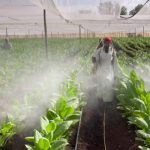From small-town farmers’ markets to grocery stores alike, organic products are everywhere. People seem to love organic produce because they are …


From small-town farmers’ markets to grocery stores alike, organic products are everywhere. People seem to love organic produce because they are …
“We want people to go back to their communities and seed these concepts, not just the aspects of sustainable agriculture, but of protecting the people …
Even for effective implementation of public policy on agriculture and food securiyu the government of the day cannot ignore accountability and …
The sun beats down on the dried Tanzanian soils. Dust is slowly settling back down to the ground in the wake of a parade of tourists’ vehicles, which are now disappearing over the horizon. It’s dry season in the Serengeti National Park, and safari trucks are groaning under the weight of excited visitors.
The park, a World Heritage Site, draws tourists from all over the world. Its ecosystem is carefully managed by hard-working park rangers — a delicate balancing act between wildlife promotion and preservation made even more daunting by poachers in pursuit of the endangered eastern black rhino.
Protecting rhinos from poachers has always been an integral part of park management. While it’s still a complicated and highly skilled endeavor, it’s been made a little easier thanks to recent advances in data communications technology. Using geolocation sensors implanted in the rhinos’ horns and novel wireless telecommunications technology known as a low-power wide-area network (LPWAN), rangers can track the Serengeti’s rhinos from a central location, then concentrate their surveillance efforts where the animals are at any given time.
Protected areas are increasingly recognized as an essential way to safeguard biodiversity. Although the percentage of land included in the global protected area network has increased from 9 to 15%, Jones et al. found that a third of this area is influenced by intensive human activity. Thus, even landscapes that are protected are experiencing some human pressure, with only the most remote northern regions remaining almost untouched.
In an era of massive biodiversity loss, the greatest conservation success story has been the growth of protected land globally. Protected areas are the primary defense against biodiversity loss, but extensive human activity within their boundaries can undermine this. Using the most comprehensive global map of human pressure, we show that 6 million square kilometers (32.8%) of protected land is under intense human pressure. For protected areas designated before the Convention on Biological Diversity was ratified in 1992, 55% have since experienced human pressure increases. These increases were lowest in large, strict protected areas, showing that they are potentially effective, at least in some nations. Transparent reporting on human pressure within protected areas is now critical, as are global targets aimed at efforts required to halt biodiversity loss.
http://science.sciencemag.org/content/360/6390/788
With its strong focus on social change for small farmers, agroecology is going mainstream worldwide, but the American food movement has yet to catch up.
Earlier this month, the United Nation’s Food and Agriculture Organization (FAO) held the 2nd International Symposium on Agroecology at its headquarters in Rome. The gathering attracted almost 800 participants, with representatives from 72 governments and 350 “non-state actors,” including civil society, academia, and the private sector. Farmers from Senegal, academics from the U.S., French parliamentarians, and staff of CropLife International, among others, gathered to debate the FAO’s claim of the urgent need to “scale up” agroecology as a means of achieving a more sustainable food system.
The symposium, hosted by the preeminent global institution on food issues, suggests that agroecology may finally be moving out of the margins. And it’s in the process of being mainstreamed.
Yet here in the U.S., it’s a different story. In fact, the word is rarely heard, even among people concerned with both agriculture and ecology. Instead, advocates—and the food industry—use the words organic, sustainable, and regenerative. And while some seem to use agroecology as an umbrella term that encompasses all of these practices, it’s more complex than that.
All the above-mentioned terms share a commitment to food production without negative impacts on the environment. What makes agroecology different, potentially, is the combination of its scientific bona fides and its rootedness in the practices and political organization of small-scale food producers from across the globe. The former—as seen in multiple scientific elaborations of agroecology’s principles, like improved soil health, crop rotation, and diversification—is complemented by the latter, which gives agroecology meaning beyond the combination of “ecological” and “agriculture.”
Agroecology is Advancing Around the Globe. Will the U.S. Take Part?
 Research shows people with healthy diets rich in fruit and vegetables are the most wasteful and calls for better education for consumers
https://www.theguardian.com/environment/2018/apr/18/americans-waste-food-fruit-vegetables-study
About 150,000 tons of food is tossed out in US households each day, equivalent to about a third of the daily calories that each American consumes. Fruit and vegetables were the most likely to be thrown out, followed by dairy and then meat.
This waste has an environmental toll, with the volume of discarded food equivalent to the yearly use of 30m acres of land, 780m pounds of pesticide and 4.2tn gallons of irrigated water. Rotting food also clogs up landfills and releases methane, a powerful greenhouse gas.
Researchers at the US Department of Agriculture analysed eight years of food data, up to 2014, to see where food is wasted and also what members of the public say they do at mealtimes. The research has been published in Plos One.
Research shows people with healthy diets rich in fruit and vegetables are the most wasteful and calls for better education for consumers
https://www.theguardian.com/environment/2018/apr/18/americans-waste-food-fruit-vegetables-study
About 150,000 tons of food is tossed out in US households each day, equivalent to about a third of the daily calories that each American consumes. Fruit and vegetables were the most likely to be thrown out, followed by dairy and then meat.
This waste has an environmental toll, with the volume of discarded food equivalent to the yearly use of 30m acres of land, 780m pounds of pesticide and 4.2tn gallons of irrigated water. Rotting food also clogs up landfills and releases methane, a powerful greenhouse gas.
Researchers at the US Department of Agriculture analysed eight years of food data, up to 2014, to see where food is wasted and also what members of the public say they do at mealtimes. The research has been published in Plos One.
‘Beyond Comprehension’: In Just Two Years, Half of All Corals in ‘Forever Damaged’ Great Barrier Reef Have Died
Global warming, researchers warn, “is rapidly emerging as a universal threat to ecological integrity and function.”
Global warming transforms coral reef assemblages
https://www.nature.com/articles/s41586-018-0041-2
After centuries of bad stewardship, communities are at last starting to see the benefits of forests.
China plans to plant forests the size of Ireland. Latin American countries have pledged to restore 20m hectares of degraded forest and African countries more than 100m hectares. India is to plant 13m hectares, and on a single day last year 1.5 million people planted 66m trees in Madhya Pradesh alone.
Much of Europe is physically greener than it was just a few years ago. England is to plant 50m trees in a new coast-to-coast forest and newly planted saplings now cover tens of thousands of hectares of former farmland in Ireland, Norway and France. From Costa Rica to Nepal and Peru to Mongolia, tree planting has become a political, economic and ecological cause, and a universal symbol of restoration, regrowth and faith in the future. More than 120 countries promised in 2015 to plant and restore large areas of forest as a response to the climate crisis, and the UN has set a target to restore 350m hectares by 2030 – an area bigger than India.
https://www.theguardian.com/commentisfree/2018/feb/13/worlds-lost-forests-returning-trees
Pesticides cause a multitude of adverse effects on humans. However, they are especially harmful to children. They may have something to do with the mass-shootings in schools all over America because some of them are neurotoxins. This means they affect and damage the central nervous system and the brain – of all animals, including humans.
Warren Porter, professor emeritus of zoology at the University of Wisconsin, conducted experiments with ground water – water drawn from the ground of farms with typical levels of pesticides and fertilizers. He chose farm water contaminated with the insecticide aldicarb, the herbicide atrazine, and nitrogen fertilizer. He tested that mixture on white mice and deer mice.
The concentrations of the fertilizer with each of the pesticides (aldicarb and atrazine) in the ground water were of the order of magnitude the Environmental Protection Agency says the chemicals cause “no unreasonable harm to man and the environment.” In other words, Porter put to the ultimate test the assurances of EPA and the chemical industry about the toxins EPA registers (approves) – that they are safe and farmers may spray on crops Americans eat.
Porter discovered the mixture of common ground water and farm chemicals had detrimental effects on the animals’ nervous, immune, and endocrine systems. The mice became aggressive and had problems with their thyroid hormones. Their immune system was also compromised in its ability to make antibodies against foreign proteins.
Organic food means food without farm sprays, sludge, radiation, and genetic engineering. This healthy food is also political food: helping us to fight pollution and control by the agrochemical-industrial-political complex.
https://www.commondreams.org/views/2018/04/14/pesticides-are-making-children-aggressive
